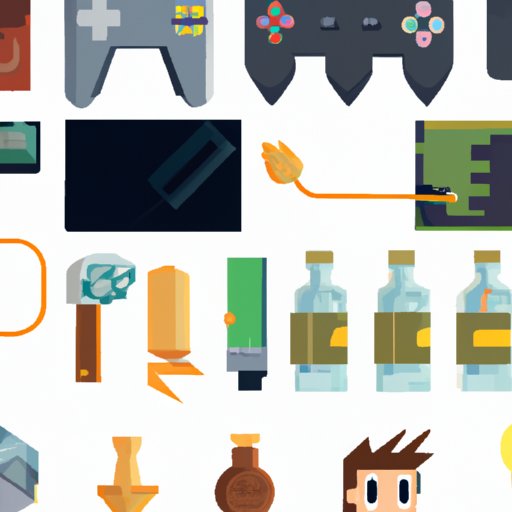Introduction
Video games have become an integral part of entertainment and culture in our society. But how are these amazing works of art created? This article will explore the process of making video games, from concept to completion. We’ll look at the different types of teams involved in game development, the various tools and techniques used, and how technology has impacted the creation of video games.

Design and Development of a Video Game from Scratch
The development of a video game begins with a concept or idea. This is usually discussed and agreed upon by a team of developers, which includes game designers, artists, programmers, sound designers, and quality assurance testers. Once the concept and game mechanics have been established, the next step is to create a game design document. This document serves as a blueprint for the rest of the development process and outlines the core features of the game, its objectives, and the user experience.
The next step is to create the art assets for the game. This includes designing characters, environments, and objects, as well as creating textures and animations. For 3D games, 3D modeling software is used to create the assets. Once the art assets are completed, they are imported into the game engine, where they can be programmed and manipulated.
Programming is the next step in the game development process. Programmers use scripting languages such as C++, Java, and Lua to write the code that makes the game work. This code is then tested and debugged to ensure that the game runs properly. Finally, the game is tested by quality assurance testers to identify any bugs or issues before it is released.
Different Types of Teams Involved in Video Game Development
Game development requires a variety of skills and knowledge, so it takes a team of talented individuals to create a successful video game. Here are some of the roles involved in the development process:
Game designers – Game designers are responsible for creating the concept and game mechanics of the game. They must also develop the storyline, level design, and other elements of the game.
Artists – Artists create the visuals for the game, such as characters, objects, environments, and animations. They use 2D and 3D software to create the art assets.
Programmers – Programmers use scripting languages to write the code that makes the game work. They must also debug and test the game to make sure it runs smoothly.
Sound designers – Sound designers create the audio for the game, such as music and sound effects. They use audio editing tools to create and manipulate the sound files.
Quality assurance testers – Quality assurance testers play the game to identify any bugs or issues before it is released. They also provide feedback on the gameplay and user experience.

Tools and Techniques Used for Video Game Design
Game development requires the use of various tools and techniques. Here are some of the most common ones:
2D and 3D software – Artists use 2D and 3D software to create the art assets for the game. Popular software programs include Adobe Photoshop, Autodesk Maya, and Blender.
Audio editing tools – Sound designers use audio editing tools to create and manipulate the sound files. Popular software programs include Audacity, Pro Tools, and Logic Pro X.
Scripting languages – Programmers use scripting languages such as C++, Java, and Lua to write the code that makes the game work. These languages allow for complex game logic and behavior.
Animation software – Animators use animation software to create realistic movements for characters and objects. Popular software programs include Toon Boom Harmony and Adobe After Effects.

Impact of Technology on the Making of Video Games
Technology has had a major impact on the way video games are made. Here are some of the ways technology has changed the game development process:
Emergence of new platforms – With the emergence of new platforms such as mobile devices, console gaming, and virtual reality, more people are able to experience video games than ever before.
Increased use of artificial intelligence – Artificial intelligence (AI) is being used more and more in video games, allowing for more immersive and realistic experiences. AI is used to create lifelike NPCs, adaptable enemies, and dynamic environments.
Virtual reality gaming – Virtual reality (VR) gaming has opened up a whole new world of possibilities for game developers. VR allows players to experience games in an entirely new way, immersing them in a 3D environment.
Augmented reality gaming – Augmented reality (AR) gaming combines the physical world with the digital world, allowing players to interact with their environment in unique ways. AR games are becoming increasingly popular, especially on mobile devices.
Conclusion
Making a video game is a complex and time-consuming process. It requires a team of talented individuals working together to create something truly amazing. Understanding how video games are made can help developers create better games and give players a more enjoyable experience. Technology is constantly evolving and impacting the way we make and play video games, so it’s important to stay up to date with the latest trends and tools.


